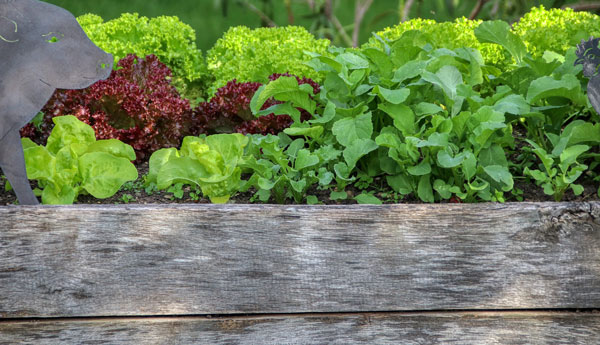
Convinced you don’t have a green thumb? Tired of having to choose between constant weeding or seeing your plants choked out? Raised garden beds may be the key to your problems, and they’re rather easy to craft. Read on for the why and how of this time- and back-saving garden addition.
Benefits
While obviously too small for large-plot crops, raised garden beds are perfect for small plots of veggies and flowers. Keeping them high and separated helps ensure the soil doesn’t get compacted by people tramping through, ensuring more aerated soil for better drainage, while also keeping it in place, instead of eroding away. Additionally, the added height presents a larger barrier for pests like snails and slugs. Finally, as mentioned above, one of the biggest benefits of a raised garden bed is the drastic amount they cut down on weeds (mostly pathway weeds) in your garden soil. Sure, a few will still pop up here and there, but when they do, you won’t have half as far to bend. If the beds are high enough, some folks even take to weeding with a stool.
Setup
Building these types of beds is about as simple as building a four-sided box. First, you’ll need to select your wood. Cedar is most prevalent, thanks to its natural rot resistance, though thanks to the arsenic-free methods used in modern pressure-treating, pressure treated wood can make an excellent second choice. Next off, decide your height. Most beds don’t eclipse three feet (36-inches), while a shade under two feet is the most common height. As you’ll be stacking 2”x6”s, figure your height roughly in six-inch variables, but don’t worry about being too precise. Remember, wood shrinks as it dries, so a 2”x6” you buy at a hardware store (not a lumber mill) is really more like a 1.5”x5”.
When figuring the rest of your dimensions, I would recommend stopping at around four-feet wide, to ensure you can easily reach the center. As far as length, it’s really dealer’s choice, though I would recommend cross-braces be installed every six-feet if you plan on making it longer than that. If your bed falls somewhere between six and 12 feet, of course, simply put the cross brace in the center. We will use half-inch thick aluminum bars for this purpose, while corner posts will be constructed from 4”x4”s
Finally, make sure you have the right tools. A power drill, drill bits, a saw and a sledge hammer will make this go a lot smoother than attempting it all with hand tools.
Process
Start by turning your bed area over to a depth of around 12-inches. This is particularly important if the soil has never been used for gardening before. After this, lay your first layer of 2”x6”s out in the rectangle that will become your bed, two-inch side down. Screw the boards together where they are butted up. Take this form and set it down around your dug area. If it doesn’t appear level, you can cut small blocks from leftover parts of 2”x6” to raise the lower end. This is more important than it sounds, as watered soil will eventually settle level, and may look awkward in a slanted bed. Next, take your 4”x4”s, and cut them around eight-inches taller than you expect the bed to be. Position them within the right angles formed by the corner of your frame, then drive these corner posts four-inches into the ground. Attach these to the 2”x4”s, using two screws per side.
From here, finishing up is easy. Add as many more layers of 2″x4”s as you wish, screwing them to each other and the 4”x4” corner posts as you go. Once you’ve gotten all in place, cut and sand the corners flush to finish. As mentioned, if the bed is longer than six feet, or taller than two feet, cross braces are a good idea. Take your half-inch thick aluminum flat bar(s), lay them/it across the bed, and screw into place on each side, either every six feet, or halfway across, depending on what length you’ve decided on. Fill the bed with whatever dirt you desire, and you’re good to go. Happy gardening!
A humble homesteader based in an undisclosed location, Lars Drecker splits his time between tending his little slice of self-sustaining heaven, and bothering his neighbors to do his work for him. This is mainly the fault of a debilitating predilection for fishing, hunting, camping and all other things outdoors. When not engaged in any of the above activities, you can normally find him broken down on the side of the road, in some piece of junk he just “fixed-up.”

Robert Dowell says
The first paragraph under process…..are you using 2x4s or 2x6s?
Gary L Weeks says
Pictures or diagrams would have been nice.